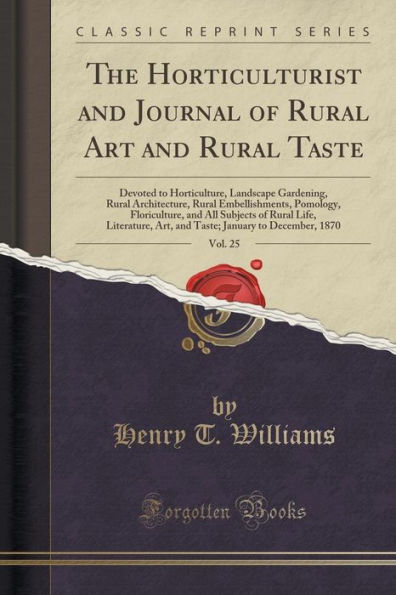Home
The Horticulturist and Journal of Rural Art and Rural Taste, Vol. 25: Devoted to Horticulture, Landscape Gardening, Rural Architecture, Rural Embellishments, Pomology, Floriculture, and All Subjects of Rural Life, Literature, Art, and Taste; January to De
Loading Inventory...
Barnes and Noble
The Horticulturist and Journal of Rural Art and Rural Taste, Vol. 25: Devoted to Horticulture, Landscape Gardening, Rural Architecture, Rural Embellishments, Pomology, Floriculture, and All Subjects of Rural Life, Literature, Art, and Taste; January to De
Current price: $16.57


Barnes and Noble
The Horticulturist and Journal of Rural Art and Rural Taste, Vol. 25: Devoted to Horticulture, Landscape Gardening, Rural Architecture, Rural Embellishments, Pomology, Floriculture, and All Subjects of Rural Life, Literature, Art, and Taste; January to De
Current price: $16.57
Loading Inventory...
Size: OS
*Product Information may vary - to confirm product availability, pricing, and additional information please contact Barnes and Noble
Excerpt from The Horticulturist and Journal of Rural Art and Rural Taste, Vol. 25: Devoted to Horticulture, Landscape Gardening, Rural Architecture, Rural Embellishments, Pomology, Floriculture, and All Subjects of Rural Life, Literature, Art, and Taste; January to December, 1870
A judicious management of the air and the water, given to house-plants, has much to do with their health. Never give them an excess of either; it is much safer to keep a plant a little dry than too moist, and with never a whiff of free air than too great a draught. A room, airy enough and warm enough for our own comfort, will suit nearly all plants. A little experience will soon show what species need greater heat, and it can be easily supplied them by allowing them more sunshine, placing them nearer the ceiling, or setting their pots on a slab of heated soap-stone. But there must be no sudden changes from heat to cold, or vice versa.
Plants flourish best in pots that will allow a free passage to all superfluous moisture such as the common unglazed flower-pots of baked clay; the material being porous enough to admit air to the roots, and the hole in the bottom of the pot serving as an outlet for the water to the saucer below. If wooden pots or boxes are used, they must have several small outlets for superfluous moisture. Glass, metal, crockery, or glazed earthen pots, should serve only as receptacles for the common clay pots. Plants, requiring loose soil, should have a layer of pebbles, a piece of broken crockery, or something similar, in the bottom of the pot, to give them proper drainage, without waste of the soil. Bits of charcoal, or of old iron, should fill this place for those plants whose blossoms would be improved by a darkening of their hues. These few general hints must suffice for the present others will be given from time to time.
About the Publisher
Forgotten Books publishes hundreds of thousands of rare and classic books. Find more at www.forgottenbooks.com
This book is a reproduction of an important historical work. Forgotten Books uses state-of-the-art technology to digitally reconstruct the work, preserving the original format whilst repairing imperfections present in the aged copy. In rare cases, an imperfection in the original, such as a blemish or missing page, may be replicated in our edition. We do, however, repair the vast majority of imperfections successfully; any imperfections that remain are intentionally left to preserve the state of such historical works.
A judicious management of the air and the water, given to house-plants, has much to do with their health. Never give them an excess of either; it is much safer to keep a plant a little dry than too moist, and with never a whiff of free air than too great a draught. A room, airy enough and warm enough for our own comfort, will suit nearly all plants. A little experience will soon show what species need greater heat, and it can be easily supplied them by allowing them more sunshine, placing them nearer the ceiling, or setting their pots on a slab of heated soap-stone. But there must be no sudden changes from heat to cold, or vice versa.
Plants flourish best in pots that will allow a free passage to all superfluous moisture such as the common unglazed flower-pots of baked clay; the material being porous enough to admit air to the roots, and the hole in the bottom of the pot serving as an outlet for the water to the saucer below. If wooden pots or boxes are used, they must have several small outlets for superfluous moisture. Glass, metal, crockery, or glazed earthen pots, should serve only as receptacles for the common clay pots. Plants, requiring loose soil, should have a layer of pebbles, a piece of broken crockery, or something similar, in the bottom of the pot, to give them proper drainage, without waste of the soil. Bits of charcoal, or of old iron, should fill this place for those plants whose blossoms would be improved by a darkening of their hues. These few general hints must suffice for the present others will be given from time to time.
About the Publisher
Forgotten Books publishes hundreds of thousands of rare and classic books. Find more at www.forgottenbooks.com
This book is a reproduction of an important historical work. Forgotten Books uses state-of-the-art technology to digitally reconstruct the work, preserving the original format whilst repairing imperfections present in the aged copy. In rare cases, an imperfection in the original, such as a blemish or missing page, may be replicated in our edition. We do, however, repair the vast majority of imperfections successfully; any imperfections that remain are intentionally left to preserve the state of such historical works.








